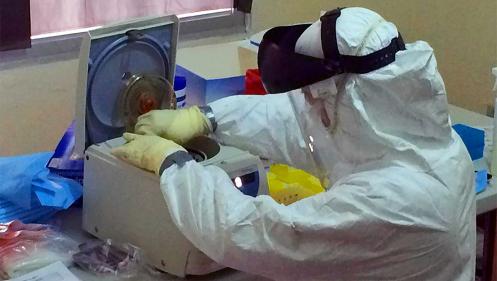The mission is for the United States to have the ability to inoculate 300m people by January 2021. In collaboration between Health and Human Services, the FDA and the Department of Defense, the DOD has a unique division known as The Research Regulatory Oversight Office (R2O2) which is the P&R component level oversight office for the authorities and responsibilities under Department of Defense (DoD) Instruction 3216.01, “Use of Animals in DoD Programs.” The R2O2 manages animal care and use review and oversight processes for research conducted and supported by the Uniformed Services University of the Health Sciences and the Armed Forces Radiobiology Research Institute, both of which are accredited by AAALAC as is required for all DoD institutions housing animals for Research, Development, Testing and Evaluation or training.
***
The Trump administration is organizing a Manhattan Project-style effort to drastically cut the time needed to develop a coronavirus vaccine, with a goal of making enough doses for most Americans by year’s end.
Called “Operation Warp Speed,” the program will pull together private pharmaceutical companies, government agencies and the military to try to cut the development time for a vaccine by as much as eight months, according to two people familiar with the matter.
As part of the arrangement, taxpayers will shoulder much of the financial risk that vaccine candidates may fail, instead of drug companies.
The project’s goal is to have 300 million doses of vaccine available by January, according to one administration official. There is no precedent for such rapid development of a vaccine.
Last month, Trump directed Health and Human Services Secretary Alex Azar to speed development of a vaccine, and administration officials have been meeting on the effort for three to four weeks, one of the people said. A meeting on the project was scheduled at the White House on Wednesday.
The people familiar with the project and the administration officials asked not to be identified because it hasn’t yet been publicly announced.
A spokesman for the Department of Health and Human Services, Michael Caputo, said the president refused to accept the timeline for standard vaccine development and encouraged a breakthrough process.
Speeding Up
Vaccine development is typically slow and high risk. The project’s goal is to cut out the slow part, the people said. Operation Warp Speed will use government resources to quickly test the world’s most promising experimental vaccines in animals, then launch coordinated human clinical trials to winnow down the candidates.
The group is discussing which Americans might be vaccinated first, as the medicines would likely roll off production lines in batches, one of the people said. The project would be funded from money already available to the government and won’t require new authority from Congress, one of the people said.
There are at least 70 different coronavirus vaccines in development by drugmakers and research groups, according to the World Health Organization. But drugmakers have not coordinated their efforts to the extent they could through the Warp Speed project, one of the people said.
Under the effort, the Defense Department would make its animal research resources available for pre-clinical work on vaccines.
The group is also discussing the use of what’s known as a master protocol to test the vaccines. Instead of multiple clinical trials run by each drugmaker, competing for patients and resources, the government would organize one large trial to test several vaccines at once and advance the most promising ones.
Oxford Vaccine
The Trump administration isn’t alone in trying to fast-track a vaccine. One of the world’s most promising vaccine candidates has been developed by a team at Oxford University in London. Last month, scientists at the U.S. National Institutes of Health innoculated six rhesus macaques with the Oxford vaccine and then exposed them to the coronavirus, the New York Times reported.
All six were healthy more than four weeks later, according to the Times. The researchers are currently testing their vaccine in 1,000 patients and plan to expand to stage two and three clinical trials next month involving about 5,000 more people.
The Oxford group told the Times they could have several million doses of their vaccine produced and approved by regulators as early as September.
In the U.S., the Bill & Melinda Gates Foundation has meanwhile shifted much of its research effort to the coronavirus virus.
One of the people familiar with Operation Warp Speed drew a distinction with the Oxford group, describing the U.S. effort as broader in scope. It’s unclear which vaccine candidates would be part of Operation Warp Speed, or whether it would include the Oxford vaccine.
More than 1 million cases of coronavirus have been confirmed in the U.S., and at least 58,000 people have died from the illness it causes in the last two months. Widespread social-distancing measures have helped slow the spread, but at the cost of millions of jobs and losses to the economy that experts fear will take years to recover.
Along with wider diagnostic testing for the virus and an effective therapeutic drug, a vaccine is one of the key tools for reducing long-term risk from the virus. Testing can help contain an outbreak in its early stages, or after it’s been curbed enough to manage. A therapy can help those who get sick, reducing the risk of death and the burden on hospitals.
Gilead Sciences Inc. announced Wednesday that in a trial conducted by Fauci’s agency, the U.S. National Institute of Allergy and Infectious Diseases, its experimental coronavirus therapy remdesivir helped patients recover faster than under standard care. More here from Bloomberg






